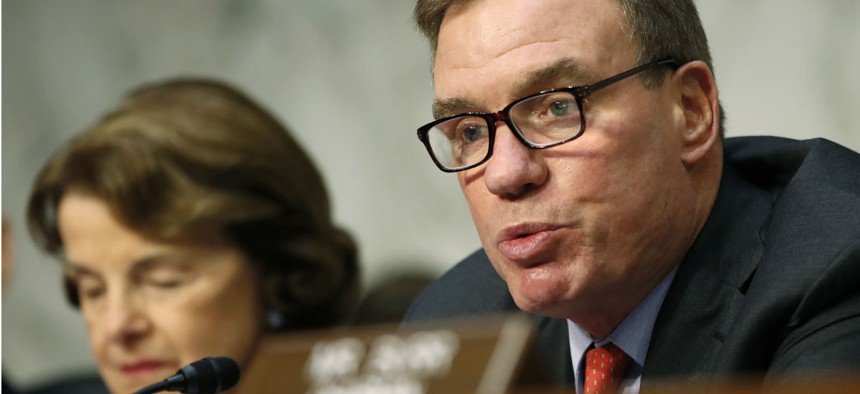
Sen. Mark Warner, D-Va., said the White House must prioritize improving the security clearance process in the coming months. Jacquelyn Martin/AP
GAO Puts Security Clearance Process Back on High Risk List
Backlog for clearances reached more than 700,000 in September 2017.
The Government Accountability Office announced Thursday that it is adding the federal government’s security clearance process to its High Risk List of federal programs that require broad transformation or specific reforms.
The National Background Investigations Bureau, which is responsible for the process, has struggled to deal with the volume of applications for security clearances, required for many government jobs. The backlog of people awaiting clearances ballooned from 190,700 in August 2014, to 581,200 in April 2017 and more than 700,000 in September of that year. The Office of Personnel Management’s goal for a stable backlog is 180,000 cases.
“A high-quality and timely personnel security clearance process is essential to minimize the risks of unauthorized disclosures of classified information and to help ensure that information about individuals with criminal histories or other questionable behavior is identified and assessed,” said Comptroller General Gene Dodaro, in a statement. “Our objective for the High Risk List is to bring attention to policymakers of the need for action sooner, rather than later.”
As reasoning for adding the process to the High Risk List, which was not scheduled for a regular update until 2019, GAO cited two of its recent reports, which identified the growing backlog and a lack of long-term goals for agencies to increase their capacity to process cases, among other issues.
Officials noted that the 2018 National Defense Authorization Act contains provisions that could improve the security clearance backlog. The law, signed by President Trump last month, requires the Pentagon to devise a “phased transition plan” to shift background checks for defense personnel from NBIB to the Defense Security Service, and it allows DSS to hire more personnel to deal with the backlog.
The security clearance process has been on and off the High Risk List in recent years. In 2005, GAO added the Defense Department’s erstwhile clearance program to the list, and in 2007 OPM’s program was added due to issues of timeliness and quality. But in 2011, the program was removed after progress was made.
“After GAO removes areas from the High Risk List, it continues to monitor them to determine if the improvements previously noted are sustained and whether new issues emerge,” GAO wrote. “If significant problems arise, GAO will put an issue back on the list, as it has done in this case.”
Evan Lesser, president of ClearanceJobs.com, a career site for individuals with an active security clearance, said GAO’s action Thursday highlights problems that many in the clearance job industry have been warning about for at least two years.
“Seeing the program placed on the GAO’s ‘High Risk List’ is just a confirmation of what recruiters, employers and security clearance applicants have been experiencing for a long time,” Lesser said. “The question now is if the placement is met with reforms that really do the job of reducing the processing times that are placing such a significant burden on industry, and discouraging quality applicants from considering great government and contracting positions.”
In a statement, House Oversight and Government Reform Committee ranking member Rep. Elijah Cummings, D-Md., renewed calls for an investigation into the security clearance process, particularly for members of the Trump administration.
“Today’s urgent action by the nonpartisan investigators at GAO confirms what I have been warning about for months: serious deficiencies in our nation’s security clearance processes represent an urgent and grave risk to our national security, not only with respect to systemic challenges, but also with respect to specific individuals who should not have access to our nation’s most highly guarded secrets,” Cummings said. “Unfortunately, [Chairman Rep. Trey Gowdy, R-S.C.] has refused all of my requests to obtain documents for the past year and has blocked all efforts to allow our committee members to vote for ourselves.”
Sen. Mark Warner, D-Va., ranking member of the Senate Select Committee on Intelligence, said in a letter to Office of Management and Budget Director Mick Mulvaney that the White House must prioritize improving the security clearance process in the coming months.
“I request that the president’s budget request for fiscal year 2019 ensures adequate funding for departments’ and agencies’ background investigations for purposes of suitability assessments and security clearances,” Warner wrote. “I also request you treat personnel security as a special topic in the budget request. It is essential that background investigations are treated as a critical mission function that receives attention from our government’s top leadership.”
Lawmakers in recent months have advanced legislation to improve reporting on the clearance backlog. The SECRET Act (H.R. 3210) would require NBIB to report the backlog of federal employees awaiting background investigations on a quarterly basis, as well as the average time required to conduct each investigation. The House approved the bill last July, and the Senate Homeland Security and Governmental Affairs Committee advanced the legislation to the full Senate last October, where it awaits a floor vote.







